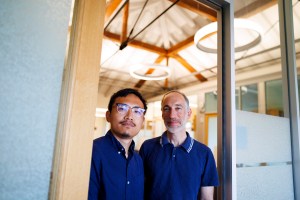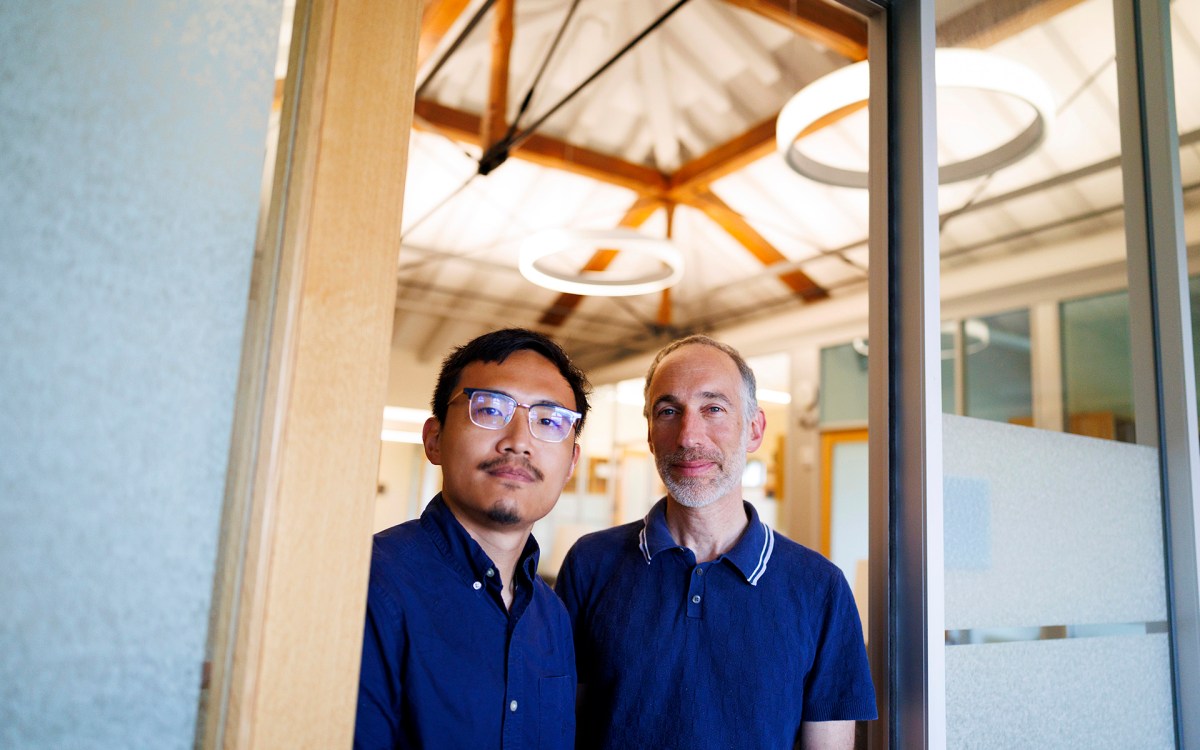Harvard turns wind into power
Commitment to green energy continues with turbines on top of Holyoke Center
Watch your footing on those slippery winter sidewalks in Cambridge. But if you’re at the corner of Dunster and Mt. Auburn streets, take a minute to look up.
About a hundred feet above is a glimpse of Harvard’s green energy future: six small-scale wind turbines on the roof of the Holyoke Center — turning, turning, turning out a little power, thanks to nature.
As of late December, Harvard’s 1960s-era office building on Massachusetts Avenue — 10 energy-hungry stories of glass and slab — is home to six rooftop AeroVironment (AV) wind turbines. Designed to generate a modest 1 kilowatt each, the 90-pound units make only enough juice to power 30 computers a day. (One kilowatt, equal to 1,000 watts, will keep 10 100-watt light bulbs burning.)
But the curvilinear turbines, spinning starlike at Holyoke’s southwest corner, are an outward sign of Harvard’s commitment to green power.
“Having wind turbines on Harvard’s flagship office building is a major statement about Harvard’s commitment to renewable energy,” said James W. Gray, associate vice president at Harvard Real Estate Services (HRES). The group manages more than a quarter of the University’s commercial and residential properties.
But Gray is quick to point out that the Holyoke wind project is not just symbolic. “You’re offsetting expensive power here,” he said, describing the New England region as “a high-cost electricity location.”
The renewable power spun from the Holyoke turbines, modest as it is, still means Harvard draws that much less from a conventional power grid run largely on fossil fuels. Gray said every little bit helps the University meet the ambitious sustainability goal it announced last summer: Reduce greenhouse gas emissions 30 percent below 2006 levels by 2016.
The Holyoke turbines, each about 6 feet tall and mounted on the roof’s parapet, are designed to harness energy from both lateral gusts and from wind drafts that climb the building’s walls. In search of peak winds, each turbine can track 30 degrees right and left, said HRES project manager Gregory Synnott.
The power they make is direct current, he said, which is then run through an inverter. From there, AC power feeds directly into the building’s power grid.
The low-noise, low-vibration units allow the 3-foot blades to turn in winds as low as 4 mph.
AeroVironment, a California-based manufacturer specializing in efficient electrical energy systems and sleek unmanned aircraft, claims the units are not a hazard to passing birds or bats. The Holyoke turbines were also vetted and approved by the city of Cambridge for zoning and for aesthetic impact.
The turbines are part of an AV line called “architectural wind” systems: small, modular, visible, and designed to take advantage of wind dynamics at the edge of building rooftops.
Holyoke’s wind-catching blades are one of two current HRES wind projects. The real estate management arm has plans to install a pair of slender pole-mounted wind turbines on the roof of Harvard’s Soldiers Field Parking Garage. They’re rated at a potent 10 kilowatts each. From 400 feet away on Western Avenue, the two Bergey Windpower Co. units will look like hovering dragonflies.
“Both of these installations are test installations,” said Gray, and will be studied for operating efficiency and payback intervals.
Both wind projects are experimental, too, he said. The Holyoke units will test the efficacy of small-scale wind generation. The Soldiers Field project will test how well mid-size turbines work in a University context.
The two wind power sites are the only ones so far for HRES. In the meantime, the management unit is also drafting a “50-Plus” energy conservation plan: a list of “a hundred different things, big and little,” said Gray — 50 for HRES residential properties and 50 for commercial properties.
The plan will roll out this year, mandating energy conservation and other sustainability measures. Low-flow water systems, for instance, have already been installed in 2,900 HRES-run graduate student apartments. The move is expected to cut 2009 water usage by 20 percent.
Tapping into wind, solar, geothermal, and energy conservation makes sense for HRES. About 21 percent of Harvard’s energy costs come from properties managed by the Harvard real estate group, said Joseph Gregory, the HRES assistant director of sustainability. The 50-Plus program, he added, “includes a zealous pursuit of renewables.”
HRES already manages three properties heated and cooled by geothermal energy, and later this year hopes to announce a large-scale solar project.
In pursuit of reducing greenhouse gases by 2016, said Gray, “we’re going to be doing some renewable things at the same time we cut demand.
“It’s going to take a lot of everything,” he said, “to get to this bold goal.”





